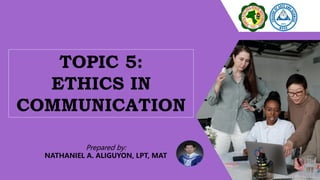
ETHICS IN COMMUNICATION: Principles and Models
- 1. TOPIC 5: ETHICS IN COMMUNICATION Prepared by: NATHANIEL A. ALIGUYON, LPT, MAT
- 2. 1) Identify the types of communication in relation to mode, context, purpose, and style. 2) Explain the various communication models. 3) Discuss the value of communication in enhancing one’s personal and professional relationships. 4) Recognize the importance of a code in ethics in communication. Lesson Objectives:
- 3. It is important to note that one’s behavior should be regulated by honesty, decency, truthfulness, sincerity, and moral uprightness.
- 4. • Establish an effective value system that will pave way for the development of integrity as a person. One’s behavior and decision- making style affect, in turn, the operation of an organization.
- 5. • Provide complete and accurate information. Data should always be contextualized and correct.
- 6. Disclose vital information adequately and appropriately. Never conceal or hide information for the purposes of transparency.
- 7. Ten Ethics in Communication Deidre D. Johnston (1994) pointed out ten ethics in communication that you should bear in mind to avoid being labeled “unethical”.
- 8. 1. Mutuality You should pay attention to the needs of others, as well as yours.
- 9. 2. Individual Dignity Do not cause another person embarrassment or a loss of dignity.
- 10. 3. Accuracy You should ensure that others have accurate information. Tell them everything they have a right and need to know, not just what is true.
- 11. 4. Access to Information Never bolster the impact of your communication by preventing people from communicating with one another or by hindering access to the supporting information.
- 12. 5. Accountability You should be responsible and accountable for the consequences of your relationships and communication.
- 13. 6. Audience As receiver of the information, you also have ethical responsibilities. A good rule of thumb is the “200% rule” where both the sender and the receiver have full or 100% responsibility to ensure that the message is understood, and that ethics are followed. This is100/100 rule, not 50/50 rule.
- 14. 7. Relative Truth As either sender or receiver of information, remember that your own point of view may not be shared by others and that your conclusions are relative to your perspective, so allow others to respectfully disagree or see it differently.
- 15. 8. Ends vs. Means You make sure that the end of goal of your communication and the means of getting to that end are both ethical although no rule can be applied without reservation to any situation.
- 16. 9. Use of Power In situations where you have more power than others (e.g. a teacher with a student, a boss with a subordinate, a parent with a child), you also have more responsibility for the outcome.
- 17. 10.Rights vs. Responsibilities Balance your rights against your responsibilities even if you live in a wonderful society where your rights are protected by law; not everything you have a right to do is ethical.
- 19. 1. Know your purpose in communicating.
- 20. Communication makes learning easier, helps students achieve goals, increases opportunities for expanded learning, strengthens the connection between student and teacher, and creates an overall positive experience. Communication serves five major purposes: to inform, to express feelings, to imagine, to influence, and to meet social expectations.
- 21. 2. Know your audience.
- 22. Knowing your audience helps you figure out what content and messages people care about. Once you have an idea of what to say, knowing your audience also tells you the appropriate tone and voice for your message.
- 23. 3. Know your topic.
- 24. It is important that you understand your subject matter before you start speaking. Content is central to any presentation. Your content must be accurate, factual, and well-organized before you start adding any kinds of bells and whistles along with it. You need to know what it is you're trying to do before you can do it. Know your topic. If you don't know sufficient detail about your topic and rely on the audience having even less knowledge you aren't being effective. Anticipate objections and be prepared to accept them.
- 25. 4. Adjust your speech or writing to the context of the situation.
- 26. Context is critical, because it tells you, the receiver, what importance to place on something, what assumptions to draw (or not) about what is being communicated, and most importantly, it puts meaning into the message.
- 27. 5. Work on the feedback given you.
- 28. The feedback tells the sender many things such as whether the message is received successfully or not, whether the receiver liked it or not, whether the choice of channel/medium is appropriate. Feedback is important in communication because it enables the sender to evaluate the effectiveness of its message. Constructive feedback motivates the sender.
- 29. Principles of Effective Oral Communication 1)Be clear with your purpose. 2)Be complete with the message 3)Be natural with your delivery. 4)Be specific and timely with your feedback.
- 30. Principles of Effective Written Communication: The 7Cs 1)Be clear. 2)Be concise. 3)Be concrete. 4)Be correct. 5)Be coherent. 6)Be complete. 7)Be courteous.
